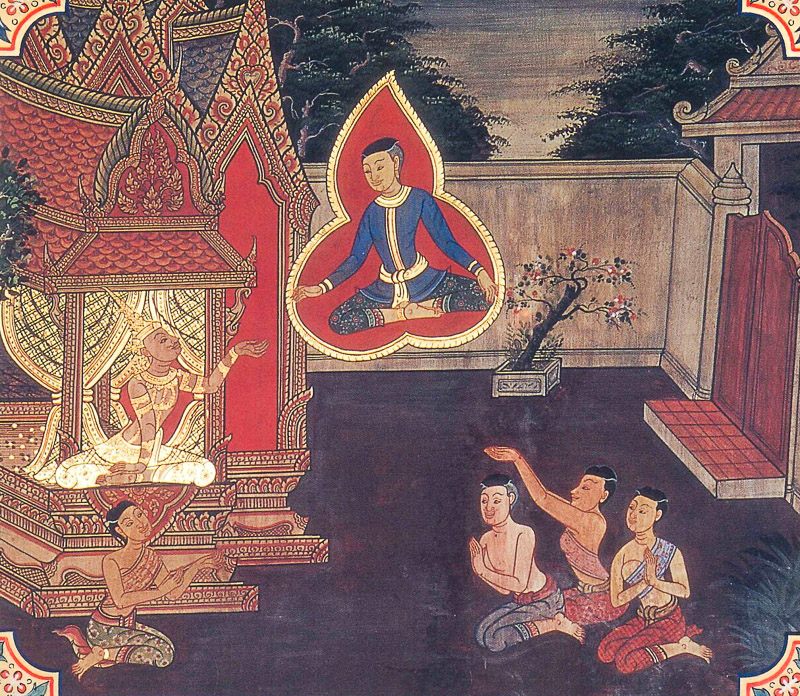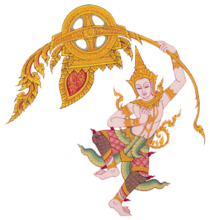
The Bodhisatta was once an illegitimate son of a king. While a king was out picking fruits and flowers in the forest, he met a peasant woman gathering firewood. They became intimate, and the Bodhisatta was conceived. The king gave the woman his signet ring in case she became pregnant: if she had a daughter she could sell the ring and use the money to raise her; if she had a son she should bring him to the palace.
One day, while he was a young boy, the Bodhisatta was out playing and the other children teased him for having no father. Upset, he ran home and asked his mother who his father was. When she told him, he demanded to go see the king, and she took him to the palace. The king knew she told the truth, but out of shame he denied his relations with her, claiming the ring was not his.
To prove she was telling the truth, she grabbed the Bodhisatta by the leg and hurled him into the air, telling the king, “If you are indeed the father of my child, I pray he stays in mid-air. But if not, may he fall and die.” The Bodhisatta floated cross-legged in the air and begged the king to accept him, which he did. His mother became the queen, and the Bodhisatta took the throne when his father died.
In the Lifetime of the Buddha
King Pasenadi, a righteous ruler and devoted supporter of the Buddha, always provided food for the Buddha’s disciples, but they did not stay and eat at the palace because the people there were not friendly. When the king found out that they went to eat at their friends’ homes, he decided to marry a woman from the Buddha’s Sakya clan in order to build closer relations with the Buddha and his disciples. However, the Sakya clan was arrogant and insular and did not want to marry into a relationship with the king; but because he was their leader, a request like this could not be refused without consequences. So they sent a daughter of a nobleman born to a slave woman and told King Pasenadi she was noble.
Knowing the Sakya clan’s reputation, the king’s assistants wanted to be sure the woman they were taking back was truly noble-born. So the family faked eating a meal together as proof. This was done by having what was claimed to be a very important letter delivered to the father at the start of the meal, so after taking just one bite he sat at the table reading rather than eating. This made it appear that he had dined with his daughter, but since he didn’t actually eat, he didn’t degrade himself with a slave.
King Pasenadi truly loved his new consort and made her his chief queen. Soon a son was born and he grew up receiving all the advantages a prince deserved, except he did not get gifts from his maternal grandfather’s family. Not wanting her son to know about her life, his mother lied and told him they sent nothing because they lived very far away. Once he grew up, he decided to visit his other family; and though she tried, his mother could not stop him.
Upon learning the prince was coming, the Sakya clan sent all their noble children younger than him away to the countryside so nobody would need to bow down in respect to someone born from a slave. A few days later, when the prince was leaving, one of his soldiers overheard a Sakya slave saying the prince’s mother had been a slave. Now knowing how the Sakyas had disrespected both his mother and him, the prince vowed to destroy them when he became king.
When King Pasenadi heard the news about his wife, he was furious and gave her and his son nothing more than he gave to his other slaves. But a few days later, the Buddha, while admitting that his clan did wrong, explained to the king that his queen and son were children of royal men and the mother’s birth was irrelevant. Then he told this story as an example of when he himself had been the illegitimate son of a king and a peasant woman but still inherited the throne. The king changed his mind and restored their honor.
The Bodhisatta’s father and mother were earlier births of the Buddha’s father and birth mother.
